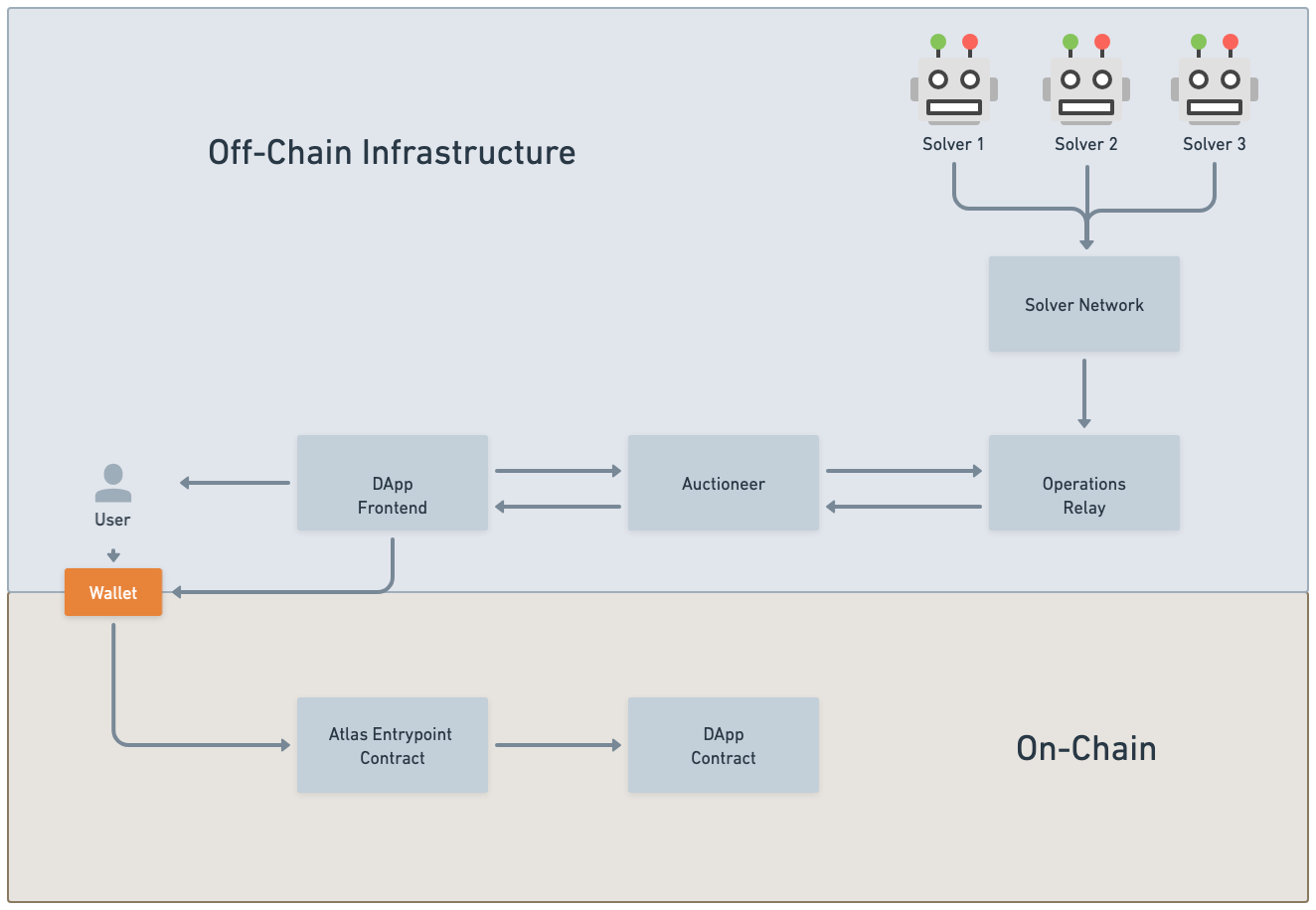System Architecture
The Atlas Protocol is engineered with a modular and extensible architecture that delineates responsibilities across distinct components. This design promotes specialization, optimization, and seamless upgrades, ensuring the protocol remains adaptable and resilient.

Overview of Components
The Atlas Protocol comprises several key components, each playing a vital role in the system's functionality:
- Atlas Smart Contracts
- Auctioneer
- Operations Relay (OR)
By separating concerns among these components, Atlas achieves modularity, allowing for specialization and independent optimization.
Atlas Smart Contracts
At the core of the Atlas Protocol are the Atlas Smart Contracts, which handle the secure and efficient on-chain execution of user operations. They manage transaction lifecycles, enforce protocol rules, and maintain the integrity of the blockchain state.
- Key Features:
- Modularity: Supports customization through modules for different use cases.
- Security: Implements robust verification and access control mechanisms.
- Extensibility: Designed for seamless integration and upgrades.
For an in-depth understanding, refer to the Atlas Smart Contracts section.
Auctioneer
The Auctioneer is an off-chain component responsible for orchestrating the bidding process among Solvers. It ensures that the most optimal solutions for user operations are selected based on predefined criteria.
- Key Responsibilities:
- Bid Collection and Aggregation
- Bid Evaluation and Ranking
- Solution Selection
Detailed information is available in the Auctioneer section.
Operations Relay (OR)
The Operations Relay acts as the communication backbone of the Atlas Protocol, facilitating secure and efficient off-chain interactions between participants.
- Core Functions:
- Message Propagation: Relays UserOps and SolverOps.
- Data Integrity: Ensures messages are complete and unaltered.
- Network Efficiency: Optimizes routing to minimize latency.
Learn more in the Operations Relay section.
Interaction Workflow
The seamless collaboration between the Atlas Smart Contracts, Auctioneer, and Operations Relay is essential for the protocol's functionality. Below is a high-level overview of their interaction:
- User Operation Submission:
- The Originator (user) signs and submits a UserOp via the Operations Relay.
- Propagation to Auctioneer and Solvers:
- The Operations Relay forwards the UserOp to the Auctioneer and Solvers.
- Solver Engagement:
- Solvers generate SolverOps with proposed solutions and send them to the Auctioneer.
- Bid Evaluation and Selection:
- The Auctioneer evaluates and selects the optimal SolverOp.
- Routing for Execution:
- The selected SolverOp is sent to the Bundler if aggregation is needed.
- On-Chain Execution:
- The Bundler compiles the transaction and invokes the
execute()function on the Atlas Entrypoint Contract. - The smart contract processes the transaction, updating the blockchain state accordingly.
- The Bundler compiles the transaction and invokes the
Component Integration
The modular design of Atlas ensures that each component interacts seamlessly while maintaining clear boundaries:
- Atlas Smart Contracts and Auctioneer:
- The Auctioneer facilitates the selection of SolverOps that the smart contracts will execute.
- Auctioneer and Operations Relay:
- Communication between these components is vital for bid collection and evaluation.
- Operations Relay and Participants:
- Acts as the hub for message propagation among users, Solvers, and the Auctioneer.
For detailed interactions of each component, please refer to their respective sections.
Benefits of the Modular Architecture
- Enhanced Security: Isolation of components reduces potential vulnerabilities.
- Improved Performance: Independent optimization leads to overall system efficiency.
- Scalability: Components can scale individually to handle increased load.
- Flexibility: Easily integrate new features or third-party services without major restructuring.
Conclusion
The Atlas Protocol's system architecture is meticulously designed to balance security, efficiency, and flexibility. By clearly defining the roles and interactions of the core components, the protocol fosters a robust environment for decentralized applications. This modular approach not only enhances current capabilities but also paves the way for future innovations and scalability within the blockchain ecosystem.
Next Steps:
- Dive deeper into each component:
- Understand the detailed flow in the Transaction Lifecycle section.